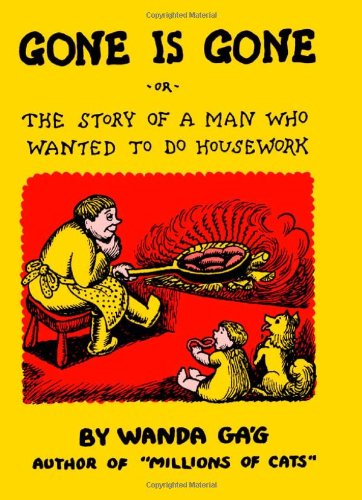-
Gone Is Gone: or the Story of a Man Who Wanted to Do Housework
Wanda Gag
Hardcover (Univ Of Minnesota Press, Sept. 24, 2003)Gone Is Gone addresses an age-old question for couples - who works harder?In this delightful story we meet Fritzl, who lives on a farm with his wife Liesi and their baby. Fritzl works hard in the fields every day. Liesi works hard all day, too, but Fritzl somehow feels that he works harder. When he complains about how hard he works and how easy Liesi has it, doing nothing but "putter and potter about the house a bit," Liesi calls his bluff and suggests they trade places.The outcomes of Fritzl's calamitous day at home are portrayed in Gag's singular illustrations. In the end Fritzl admits that Liesi's work is "none too easy" and begs to return to his fields and not do housework another day.
-
Tales from Grimm
Wanda Gág
Paperback (Univ Of Minnesota Press, Sept. 10, 2006)Renowned children’s book author Wanda Gág presents these classic Grimm tales, accompanied by whimsical illustrations. Drawing on her peasant heritage and childlike sense of wonder, Gág translated the fairy tales in a uniquely American vernacular tongue. In Tales from Grimm we find her touch on timeless stories like “Hansel and Gretel,” “The Musicians of Bremen,” “Rapunzel,” and others. No other editions of Grimm’s fairy tales for children can match Gág’s richness of prose and the humor, beauty, and sheer magic of her pictorial interpretation. Best known for her Newbery Honor winner Millions of Cats, Wanda Gág (1893–1946) was a pioneer in children’s book writing, integrating text and illustration. Born in New Ulm, Minnesota, she rose to international acclaim. In recognition of her artistry, she was posthumously awarded the 1958 Lewis Carroll Shelf Award for Millions of Cats and the 1977 Kerlan Award for her body of work. X
X
-
Song of Sampo Lake
William Durbin
Paperback (Univ Of Minnesota Press, Feb. 14, 2011)For fifteen-year-old Matti Ojala and his family, Finnish immigrants in Minnesota in 1900, starting a new life in America is both a hardship and an opportunity. After a tragic mining accident kills their beloved uncle, the family turns away from on the iron mines to pursue the dream of owning a homestead in the wilderness. This means constant hard work and new challenges for the entire family. But will it also allow Matti, the in-between child, the chance to escape from his older brother’s shadow and gain the approval of his father, which he so desperately desires?
-
Nothing At All
Wanda Gag
Hardcover (Univ Of Minnesota Press, Aug. 5, 2004)"Nothing at All" is the name of an orphaned puppy living with his two brothers until two children come to adopt them. Unfortunately, Nothing at All is left behind - not out of cruelty, but because he is invisible!He is horribly lonely until he meets a bird, Jackdaw, who says that he knows how to make the puppy visible. Nothing at All doesn't think much of the bird at first, but follows the instructions anyway, and after a little time, hard work, and a lot of dizziness, the puppy becomes visible and joins his brothers in their new family. S
S
-
The Funny Thing
Wanda Gag
Hardcover (Univ Of Minnesota Press, Sept. 24, 2003)Wanda Gag is a sequel to Millions of Cats. N
N
-
More Tales from Grimm
Wanda Gag, Wilhelm Grimm, Jacob Grimm
Paperback (Univ Of Minnesota Press, Sept. 10, 2006)Renowned children’s book author Wanda Gág presents these classic Grimm tales, accompanied by whimsical illustrations. Drawing on her peasant heritage and childlike sense of wonder, Gág translated the fairy tales in a uniquely American vernacular tongue. More Tales from Grimm contains over thirty more, including “The Golden Key,” “The Seven Swabians,” and “The Wolf and the Fox,” as well as almost one hundred illustrations. No other editions of Grimm’s fairy tales for children can match Gág’s richness of prose and the humor, beauty, and sheer magic of her pictorial interpretation. Best known for her Newbery Honor winner Millions of Cats, Wanda Gág (1893–1946) was a pioneer in children’s book writing, integrating text and illustration. Born in New Ulm, Minnesota, she rose to international acclaim. In recognition of her artistry, she was posthumously awarded the 1958 Lewis Carroll Shelf Award for Millions of Cats and the 1977 Kerlan Award for her body of work. N
N
-
Long Ships Passing: The Story Of The Great Lakes
Walter Havighurst
Paperback (Univ Of Minnesota Press, )None
-
Snippy And Snappy
Wanda Gag
Hardcover (Univ Of Minnesota Press, Sept. 24, 2003)In Snippy and Snappy, we are introduced to brother and sister field mice living with their mother and father in a cozy nook in a hay field. Their father enthralls them with stories about gardens in big fields, houses in big gardens, kitchen cupboards in big houses, and big yellow cheeses in big kitchen cupboards.One day Snippy and Snappy wander away from home while playing with their mother's yarn ball. Their journey takes them to a large house full of mysterious things, including cupboards full of wonderful-smelling cheese. Just as Snappy is about to nibble a piece of cheese in a mousetrap, their father jumps down to rescue them and lead them safely back home. Gag's delightfully detailed illustrations capture the coziness, wonder, and playfulness of Snippy and Snappy's adventures. I
I
-
Blackwater Ben
William Durbin
Paperback (Univ Of Minnesota Press, Jan. 1, 2014)According to thirteen-year-old Ben Ward’s father, lumberjacks look forward to two things: mealtime and springtime. In the winter of 1898, Ben leaves school for a job as a cook’s assistant to his father at the Blackwater Logging Camp. As Ben spends long hours peeling potatoes and frying flapjacks, he dreams of working in the woods with the other men, felling trees, driving a team, and skidding timber. While enduring a long, cold winter in a camp filled with outlandish characters, as well as an orphan boy named Nevers, Ben comes to understand himself and his family’s past. Peppered throughout with heart and humor—and including a glossary and afterword with facts about logging—Blackwater Ben paints a vivid picture of the north woods of Minnesota at the end of the nineteenth century. T
T
-
New Way Of The Wilderness: The Classic Guide to Survival in the Wild
Calvin Rutstrum
Paperback (Univ Of Minnesota Press, Aug. 23, 2000)Sports/Travel The complete resource on backcountry camping from a legendary wilderness expert. In this classic guide, first published in the late 1950s, Rutstrum covers the key elements of a successful camping trip: the proper way to build a raft, chop down a tree, construct a campsite, cook over a campfire, find a way through the woods, and much more. Drawing upon his vast experience in all kinds of weather, Rutstrum provides essential knowledge for every camper, in a lightweight volume perfect for the backpack. "A clear and comprehensive book by one who obviously is a master of do-it-yourself procedures. . . . This text is designed for both novices and experienced travelers in the true wilderness, although it touches on life in less rigorous reaches." Kirkus "A rich mine of information on camping, traveling, and surviving in wilderness areas. Primarily a personal reference book, but also a volume that many persons who enjoy outdoor recreation, as well as 'armchair outdoorsmen,' can read from cover to cover. The sections on food, on living in frigid wilderness areas, and on direction finding contain materials not readily found elsewhere. Also included are valuable checklists of equipment and supplies to take on wilderness expeditions." Library Journal For biographies of Calvin Rutstrum and Leslie Kouba, see left. Fesler-Lampert Minnesota Heritage Book Series Translation Inquiries: Simon & Schuster
-
Through No Fault of My Own: A Girl’s Diary of Life on Summit Avenue in the Jazz Age
Coco Irvine, Peg Meier
Paperback (Univ Of Minnesota Press, March 30, 2011)On Christmas Day, 1926, twelve-year-old Clotilde “Coco” Irvine received a blank diary as a present. Coco loved to write—and to get into scrapes—and her new diary gave her the opportunity to explain her side of the messes she created: “I’m in deep trouble through no fault of my own,” her entries frequently began. The daughter of a lumber baron, Coco grew up in a twenty-room mansion on fashionable Summit Avenue at the peak of the Jazz Age, a time when music, art, and women’s social status were all in a state of flux and the economy was still flying high. Coco’s diary carefully records her adventures, problems, and romances, written with a lively wit and a droll sense of humor. Whether sneaking out to a dance hall in her mother’s clothes or getting in trouble for telling an off-color joke, Coco and her escapades will captivate and delight preteen readers as well as their mothers and grandmothers. Peg Meier’s introduction describes St. Paul life in the 1920s and provides context for the privileged world that Coco inhabits, while an afterword tells what happens to Coco as an adult—and reveals surprises about some of the other characters in the diary.
